Observing and recording animal behaviour is crucial for ensuring their well-being and identifying health or welfare issues. In an animal care setting, following workplace procedures ensures consistency and accuracy in these observations.
A structured approach to help:
Preparation
- Review Workplace Procedures: Ensure you're familiar with the organization's standard protocols for observation and documentation.
- Prepare Tools: Have necessary tools like notepads, tablets, or behaviour checklists ready for accurate recording.
- Understand the Animal's Routine: Familiarize yourself with the normal behaviour of the animal species or group to identify deviations.
Key Observational Areas
- Physical Health
- Posture and Movement: Are there any signs of lameness, stiffness, or reluctance to move?
- Appearance: Look for changes in coat, feathers, skin condition, or body weight.
- Appetite and Feeding: Is the animal eating regularly? Is it finishing its meals?
- Behavioural Health
- Normal Behaviour: What does normal behaviour look like for this animal? Playfulness, rest, and interaction with its environment or others.
- Social Interaction: How does the animal interact with other animals? Aggression, submission, or isolation could indicate issues.
- Stress Indicators: Watch for pacing, excessive grooming, or vocalization.
- Environmental Interaction
- Use of Enclosure/Space: Is the animal exploring and utilizing its space?
- Response to Humans: How does the animal react to caregivers or strangers? Any signs of fear, aggression, or comfort?
Recording Observations
- Be Objective: Avoid interpreting behaviours subjectively. Describe what you see clearly (e.g., "The dog barked when approached by another dog").
- Use Behavioural Checklists: If available, use specific criteria like "resting," "eating," "socialising," and "grooming."
- Note Time and Duration: Record when behaviours occur and how long they last. This can highlight patterns (e.g., aggression during feeding times).
- Record Changes: Note any changes from the animal’s baseline behaviour.
Review and Action
- Communicate Findings: Share any concerning observations with supervisors or veterinarians according to workplace protocols.
- Follow-Up: Continue monitoring for any developments and adjust care plans if necessary.
Watch
The next video is from the Staten Island Museum, explaining how they study/ observe animals.
Before we dive into this module, let's quickly refresh on the types of enrichment.
Types of Enrichment
Modifying the environment promotes natural behaviours and encourages physical activity.
- Examples include Foraging activities (scatter feeders, snuffle mat), long walks, agility, playing fetch, climbing structures (bird perches, scratching posts, climbing frames), providing hiding places, and providing water features (pools, streams).
Providing mental challenges to stimulate cognitive functions and improve their problem-solving skills
- Examples include Puzzle feeders, Snuffle Mats, Training, providing challenges to activate problem-solving skills in animals
Encouraging interactions with other animals, humans and their environment to develop social skills and fulfil their social needs.
- Examples include Providing activities with other animals and humans, exposing animals to new environments and situations (such as vet clinics, public areas, and dog parks)
Engaging the senses through various stimuli to mimic natural environments. Providing animals with activities and enhancing their environment to stimulate their senses – touch, taste, smell, sight and hearing.
- Examples include Foraging for food, playing music and TV when not at home, providing scents in the area, puzzle feeders

When working with either individuals or groups of animals, it is important that you understand their behaviour. Therefore, it is necessary that you observe those animals (individuals or groups) and record their behaviour.
The recording of their behaviour must be completed by your organisation's policies and procedures.
Individual VS Group
When observing and recording group behaviour versus individual behaviour in animals, the focus and methods can differ. Both types of observations provide valuable insights into animal welfare, social dynamics, and health.
Individual Behaviour
Observing an individual animal's behaviour helps in understanding its unique personality, health, and well-being. The goal is to identify changes that may indicate stress, illness, or discomfort.
Key Aspects
- Physical Health: Monitor signs of injury, illness, or discomfort (e.g., limping, grooming patterns).
- Eating and Drinking: Track how much the individual consumes and it's eating patterns.
- Activity Levels: Is the animal more or less active than usual? Is it engaging in typical species-specific behaviours like hunting, foraging, or resting?
- Emotional State: Look for indicators of stress, fear, or aggression (e.g., vocalization, pacing).
- Response to Human Interaction: Does the animal display fear, friendliness, or aggression when approached by humans?
- Routine Behavior: Compare observed behaviors to the individual’s normal patterns.
Group Behaviour
Observing groups of animals involves understanding the social dynamics within the group. Social animals may behave differently when they are in groups, and group behaviours can reveal important information about hierarchy, cooperation, or social stress.
Key Aspects
- Social Hierarchy: Identify dominant and subordinate animals. Watch for any bullying, submission, or aggression.
- Group Coordination: How do the animals move together? For example, are they foraging, migrating, or resting as a group?
- Communication: Look for vocalizations, body language, or other forms of communication within the group.
- Cooperation and Conflict: Do animals work together (e.g., cooperative hunting or grooming)? Are there frequent fights or tensions?
- Sharing Resources: Observe how animals share food, water, or shelter. Are some animals excluded from these resources?
- Bonding and Grooming: Note affiliative behaviours, such as grooming or play. These can indicate strong social bonds.
- Stress or Disturbance: A disturbance in group dynamics (e.g., overcrowding, lack of resources) might result in increased aggression or isolation.
Watch
The next video will explain methods of sampling animal behaviour.
Case Study
Happy Paws Animal Care Facility- Monitoring the Behaviour of Cats in a Communal Environment
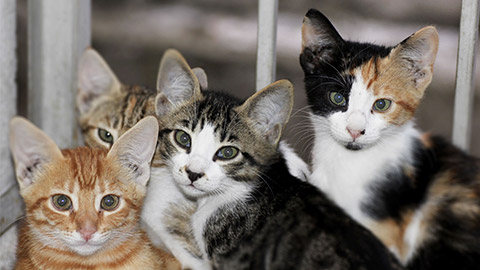
Happy Paws Animal Care recently introduced a new communal play area for cats in their boarding facility. The area allows multiple cats to interact, providing both individual and group enrichment. It was important for staff to monitor and record both individual and group behaviours, as this helps identify social compatibility and individual health or stress issues. This case study outlines the observation and recording process for a group of housed cats.
Animals Involved:
- Luna: A 2-year-old female domestic short-haired cat known for being friendly and social.
- Max: A 3-year-old male Maine Coon, generally more reserved and independent.
- Bella: A 1.5-year-old female Siamese, typically curious and energetic.
- Oscar: A 4-year-old male Ragdoll, calm and often relaxed, with a tendency to avoid confrontation.
Observation Process
- Preparation
- Reviewing Procedures: All staff members reviewed the Happy Paws procedure manual for observing and recording animal behaviour. They familiarized themselves with the guidelines for monitoring both individual and group behaviours.
- Setting Up Tools: The team prepared observation sheets with checkboxes for common behaviours like play, grooming, aggression, and isolation. These sheets would help record behaviours in 15-minute intervals for both individual and group activities.
- Observing Individual Behaviour
- Each cat was monitored individually at first to establish a baseline of normal behaviour in the new environment.
- Luna: Luna emerged as a socially dominant figure, initiating most of the group interactions. Bella’s high energy created excitement, but she didn’t challenge Luna’s social standing. Max and Oscar remained more on the outskirts of the group.
- Recording: “Luna shows social dominance, initiating interactions with other cats. Max and Oscar remain more solitary but non-aggressive. Bella is active but avoids engaging socially.”
- Max: Max was more hesitant, staying near the room's edges. He avoided interacting with the other cats initially but seemed relaxed while resting.
- Recording: “Max observed other cats from a distance, avoiding direct interaction. Rested in the corner but appeared comfortable.”
- Bella: Bella moved quickly between areas, frequently pouncing on toys and darting around other cats. She seemed energetic but wasn’t interested in interacting socially.
- Recording: “Bella displayed high energy, frequently chasing toys and running. No signs of stress but avoided social interaction.”
- Oscar: Oscar calmly walked around the space, occasionally sitting near other cats but not engaging much. He appeared content but showed no interest in joining play activities.
- Recording: “Oscar remained calm, sitting near others but avoiding direct engagement. No signs of stress.”
- Luna: Luna emerged as a socially dominant figure, initiating most of the group interactions. Bella’s high energy created excitement, but she didn’t challenge Luna’s social standing. Max and Oscar remained more on the outskirts of the group.
- Each cat was monitored individually at first to establish a baseline of normal behaviour in the new environment.
- Observing Group Behaviour
- Once the cats had been observed individually, the staff shifted focus to their interactions within the group.
- Social Hierarchy: Luna emerged as a socially dominant figure, initiating most of the group interactions. Bella’s high energy created excitement, but she didn’t challenge Luna’s social standing. Max and Oscar remained more on the outskirts of the group.
- Recording: “Luna shows social dominance, initiating interactions with other cats. Max and Oscar remain more solitary but non-aggressive. Bella is active but avoids engaging socially.”
- Play Behaviour: Bella’s energetic movements influenced the group dynamics. When Bella engaged with toys, Luna joined in, encouraging group play. Max and Oscar continued to observe from a distance but showed signs of curiosity.
- Recording: “Bella and Luna engaged in group play, chasing toys together. Max and Oscar observed but didn’t join in the activity.”
- Aggression or Tension: No signs of aggression were observed. Max and Oscar maintained their distance, showing no signs of stress, while Luna and Bella’s interactions were friendly.
- Recording: “No aggressive behaviours observed. Luna and Bella displayed friendly play interactions, while Max and Oscar remained solitary but calm.”
- Use of Space: Luna and Bella explored the communal area fully, engaging with toys and different play stations. Max and Oscar confined themselves to specific areas, suggesting they preferred quieter spots.
- Recording: “Luna and Bella used the full space, actively exploring. Max and Oscar stayed near the edges but appeared relaxed.”
- Social Hierarchy: Luna emerged as a socially dominant figure, initiating most of the group interactions. Bella’s high energy created excitement, but she didn’t challenge Luna’s social standing. Max and Oscar remained more on the outskirts of the group.
- Once the cats had been observed individually, the staff shifted focus to their interactions within the group.
- Outcome and Action Plan
- After a full day of observation, the staff concluded that while there were no immediate concerns, Max and Oscar’s solitary behaviour should be monitored in the coming days to ensure they were not experiencing stress or anxiety in the communal environment.
- Action: Introduce new enrichment activities, such as interactive toys and climbing structures, to see if Max and Oscar become more engaged. Continue observing group dynamics, particularly Luna’s dominant social role, to ensure no emerging tension develops.
- After a full day of observation, the staff concluded that while there were no immediate concerns, Max and Oscar’s solitary behaviour should be monitored in the coming days to ensure they were not experiencing stress or anxiety in the communal environment.
- Conclusion
- The observation and recording of both individual and group behaviours provided valuable insights into the social dynamics within the communal cat environment at Happy Paws. The team successfully identified Luna’s leadership role and ensured Max and Oscar, while more solitary, showed no signs of stress. Regular observation allowed the facility to adapt the environment and activities to meet the needs of all the cats.

It is said that the study of animal behaviour can show us information about the foundation for animal training or, more generally, the area of animal care. It may also provide a very real insight into the understanding of our own human behaviour.
As you may have seen from your own past experiences with animals, they share some behavioural characteristics with people. Do not assume too much similarity, as this can be dangerous, and you may get the wrong signals. Animal behaviour is far less affected by choices reached through reasoning.
What is animal behaviour?

Behaviour is any externally observable activity of an animal.
Animal behaviour is how an animal acts or reacts to other organisms or the environment.
In general, it includes:
- Animal activities and responses based on:
- Species, breed, age and sex of the animal
- The time of the day or night
- The breeding season
- The environment
- Normal behaviour in various contexts:
- Breeding
- Eliminative
- Grooming
- Ingestive
- Resting
- Social
- Sexual
- Maternal
- Communicative
- Shelter seeking
- Feeding
- Investigative
- Allelomimetic
- Maladaptive
Abnormal behaviour is a behaviour that is generally out of character for that individual, is an atypical response to a stimuli or event or an increase or decrease in intensity of a typically 'normal' behaviour.
- Abnormal behaviour:
- Exaggerated forms of normal behaviour
- Repetitive patterns or actions
- Stationary, non-purposeful movements
It is important not to confuse abnormal behaviour with abnormal clinical signs of disease. For example, Lethargy or dull mentation is not a behaviour. It is a clinical sign. Clinical signs are an involuntary response to illness or injury.
This is not to be confused with abnormal clinical signs of disease, and I have found when teaching, this often gets mixed up. For example, lethargy or dull mentation is not a behaviour. It is a clinical sign.
Behaviour is an action in response to a stimulus.
Watch
The next video is a quick crash course on Animal Behaviour.
Animals may include:
- Animals commonly encountered within the industry workplace and may cover both native and introduced species
- Animals from the six major animal groups (mammals, birds, reptiles, amphibians, fish and invertebrates).
Purpose of animal behaviour

People assume that all animal behaviour is designed to support the natural survival of the animal, either directly or indirectly. This is not always the case; animals can behave self-destructively, out of habit, or purely out of boredom, just as humans can. To better understand the behaviour, we should also consider what motivates the animal to behave in such a manner.
Watch
The next video provides more information on the purpose of animal behaviour and the research humans have done into it.
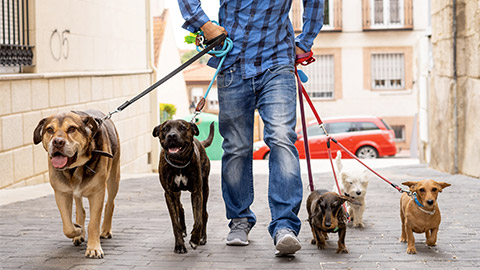
Animal behaviour is driven by a combination of internal and external factors, which include physiological needs, environmental conditions, social dynamics, evolutionary adaptations, and learned experiences. These motivations are crucial for survival, reproduction, and maintaining well-being.
Several areas can motivate an animal to behave in a certain way. But we will look at the two main areas that animals get their behaviour from
Two main areas are
- Genetics
- Learned/environmental

Genetics in animals refers to the study of heredity and how traits and characteristics are passed from one generation to the next through genes. These inherited traits affect everything from an animal’s appearance (such as coat colour, size, and body structure) to its behaviour, health, and susceptibility to certain diseases. Understanding genetics is fundamental to animal breeding, conservation, veterinary science, and research.
Here is a break down on how it all works in relation to animals:
The basic concept of genetics
Genes
- Genes are the basic units of heredity, made of DNA (Deoxyribonucleic Acid). Each gene carries instructions for producing proteins, which perform various bodily functions.
- In animals, genes determine traits like fur colour, ear shape, eye colour, and even behavioural tendencies like aggression or calmness.
Chromosomes
- Genes are located on structures called chromosomes, which are found in the nucleus of every cell.
- Animals inherit chromosomes in pairs, with one set coming from each parent. Most animals have a specific number of chromosomes that varies by species (e.g., humans have 46, dogs have 78, and cats have 38).
- Chromosomes are divided into autosomes (which determine most body traits) and sex chromosomes (which determine an animal’s sex).
DNA (Deoxyribonucleic Acid)
- DNA is the molecule that carries genetic information. It is structured as a double helix and contains the instructions that govern how organisms develop, function, and reproduce.
- DNA is composed of four chemical bases (Adenine [A], Thymine [T], Cytosine [C], and Guanine [G]), which pair together (A with T and C with G) to form the genetic code.
How inheritance works
Alleles and Dominance
- Alleles are different versions of the same gene. For example, in dogs, there may be different alleles for coat colour (black vs. brown).
- Some alleles are dominant, meaning they will be expressed if present (e.g., black fur in dogs may be dominant). Others are recessive, meaning they will only be expressed if an animal inherits two copies of the recessive allele (e.g., a dog must inherit two copies of a brown fur gene to have brown fur).
- Homozygous refers to an individual that has two copies of the same allele (e.g., both black fur genes), while heterozygous refers to an individual with one dominant and one recessive allele (e.g., one black and one brown gene).
Mendelian Inheritance
- Gregor Mendel first described the basic principles of inheritance through his experiments with pea plants. These principles apply to animals as well.
Mendel’s Laws:
- Law of Segregation: Each parent contributes one allele for each gene, and offspring inherit one from each parent.
- Law of Independent Assortment: Genes for different traits (e.g., coat colour and tail length) are inherited independently of each other, allowing for genetic variation.
Punnett Squares
- A Punnett square is a diagram used to predict the genetic makeup (genotype) and appearance (phenotype) of offspring based on the parent's genes.
- For example, if a black-furred dog (heterozygous) is bred with a brown-furred dog (homozygous recessive), a Punnett square can help predict the possible fur colours of their puppies.
Types of Traits
Single-Gene (Monogenic) Traits
- Traits controlled by a single gene are called monogenic traits. These are usually straightforward to predict in terms of inheritance.
- Example: Coat colour in some breeds of animals, where one gene controls the colour.
Multiple-Gene (Polygenic) Traits
- Polygenic traits are controlled by multiple genes, which makes them more complex to predict.
- Example: Height, body size, and behaviour are often polygenic in animals.
Co-dominance and Incomplete Dominance
- Co-dominance: Both alleles are expressed equally. For example, in some cattle breeds, you might see a mix of red and white hairs.
- Incomplete Dominance: Neither allele is completely dominant, resulting in a blending of traits. For instance, crossing red and white flowers might produce pink offspring.
Genetic Variation
Genetic variation is essential for the survival and evolution of species. It arises through several mechanisms:
- Mutations: Random changes in a gene's DNA sequence can lead to new traits. Some mutations are beneficial, while others may cause diseases.
- Recombination: During reproduction, chromosomes exchange segments of DNA, which can produce new genetic combinations in offspring.
- Gene Flow: The movement of genes between populations, such as through migration, introduces new genetic material to a population.
Selective Breeding in Animals
Selective breeding is a process where humans control the mating of animals to produce offspring with desired traits. This practice has been used for centuries to enhance or reduce specific characteristics.
- Breeding for Traits: Farmers or breeders may select animals with desirable traits (such as milk production in cows, speed in horses, or temperament in dogs) and breed them to pass on those traits to their offspring.
- Line Breeding vs. Crossbreeding
- Line Breeding: Mating animals that are closely related (within the same bloodline) to reinforce desirable traits.
- Crossbreeding: Mating animals from different breeds to combine desirable traits from both parents.
Genetic Disorders in Animals
Just like humans, animals can inherit genetic disorders. These are often the result of mutations or the inheritance of recessive genes.
- Inherited Disorders: Many genetic disorders are recessive, meaning animals need two copies of the defective gene to express the disorder. Common examples include hip dysplasia in dogs or progressive retinal atrophy in certain cat breeds.
- Breed-Specific Diseases: Certain diseases are more prevalent in specific breeds due to selective breeding practices. For instance, brachycephalic dogs (such as bulldogs) are prone to breathing issues due to their shortened skull structure.
Application of Animal Genetics
- Conservation: Genetics helps conserve endangered species by maintaining genetic diversity and preventing inbreeding in small populations.
- Cloning: Genetic cloning of animals is used in research and agriculture to replicate animals with desirable traits.
- Gene Editing: Emerging technologies, like CRISPR, allow for precise modifications to an animal’s genetic code to enhance health, reduce disease, or improve production traits in agriculture.
Epigenetics in Animals
Epigenetics refers to changes in gene expression that do not involve alterations to the DNA sequence itself. Environmental factors such as diet, stress, or toxins can cause genes to be "turned on" or "turned off."
- Example: A cow's milk production may be influenced by its environment and diet, even though its genetic potential for milk production remains unchanged.
Genetics is of prime importance (i.e. inherited characteristics). Genetic characteristics are also sometimes referred to as:
- Inborn characteristics
- Innate characteristics
- Instinctive characteristics
Most animals are genetically programmed to act in certain ways in certain situations.
Innate behaviour is a type of behaviour that is controlled by genes. Watch this video to learn more.
Watch
The next video explains genetics and how it works.

Learned Behaviour (i.e. Experience characteristics)
Experience may encompass terms including: “acquired”, “experiential” or “environmental”. Behaviours can be learned through the experience of interacting with the environment (which includes the people or other creatures in it), or they can be learned through personal, subjective experience (perceptions, thoughts and feelings). In the case of animals, these latter factors are usually difficult to identify.
Types of Learned Behaviour
Habituation
- Definition: Habituation occurs when an animal becomes accustomed to a repeated, neutral stimulus and stops responding to it. The animal "learns" that the stimulus poses no threat or significance.
- Example: Birds in a city may initially be scared of humans but will eventually stop flying away as they get used to human presence.
Classical Conditioning
- Definition: Classical conditioning involves associating a neutral stimulus with a significant one so the animal learns to respond to the neutral stimulus similarly.
- Example: In Pavlov’s famous experiment, dogs learned to associate the sound of a bell with food, so they started salivating at the sound of the bell, even without food present.
Operant Conditioning (Trial and Error Learning)
- Definition: Animals learn to associate a behaviour with a consequence, such as a reward or punishment. This type of learning involves the animal trying different actions and learning from the results.
- Example: A dog may learn to sit on command if it’s consistently rewarded with treats when it sits. On the flip side, it might stop jumping on people if it’s consistently ignored or scolded when it jumps.
Observational Learning
- Definition: Animals can learn by watching and mimicking the behaviour of others. This is particularly common in social animals, where young animals observe and imitate adults.
- Example: Young chimpanzees learn how to use tools by watching older chimpanzees use sticks to extract termites from a mound.
Imprinting
- Definition: Imprinting is a form of learning that occurs at a specific life stage and is often irreversible. It usually happens early in an animal’s life and helps them identify important individuals (like parents) or places.
- Example: Ducklings will imprint on and follow the first moving object they see after hatching, typically their mother, but they can also imprint on humans if that’s their first contact.
Environmental factors

Environmental factors refer to external conditions and stimuli that influence an animal's behaviour, either directly or indirectly. The environment an animal lives in can have a profound effect on its development, health, and learned behaviours.
Availability of Resources
- Food and Water: Scarcity or abundance of food and water will drastically influence behaviours like foraging, hunting, migration, and territoriality.
- Example: A herd of deer may alter its migration patterns if a drought depletes food and water resources in their typical range.
- Shelter and Safety: The need for shelter or safe spaces from predators can shape behaviours related to nest-building, burrowing, or finding refuge.
- Example: Birds in urban environments often adapt by nesting in buildings instead of trees.
Climate and Seasons
Animals adapt their behaviours based on seasonal changes such as temperature shifts, daylight hours, and weather conditions.
- Example: Some animals hibernate during winter (bears) or migrate to warmer climates (birds, whales).
Extreme weather events, such as floods, droughts, or bushfires, can also drive sudden changes in behaviour, forcing animals to seek new habitats.
Habitat
- Natural Habitat: Animals often adapt to specific environments such as forests, deserts, or aquatic ecosystems, influencing their movement patterns, breeding habits, and feeding strategies.
- Example: Fish living in fast-moving rivers will have different swimming and feeding behaviours than fish in still ponds.
- Human-Altered Environments: Urbanization or habitat destruction forces animals to adapt to new surroundings, which can lead to changes in foraging, nesting, or mating behaviours.
- Example: Foxes and raccoons may change their feeding behaviours, becoming more nocturnal and scavenging for human food in urban areas.
Social Environment
Social interactions within groups or between individuals significantly influence behaviour. An animal’s position in a dominance hierarchy, for example, can determine access to food, mates, and shelter.
- Example: Wolves in a pack have well-established social structures, where dominant individuals eat first and control group activities like hunting.
Human Influence
- Training and Domestication: Humans have shaped the behaviour of animals for thousands of years through domestication, selective breeding, and training.
- Example: Dogs have been domesticated to respond to commands and coexist peacefully with humans, whereas wild animals often remain fearful or aggressive toward people.
- Environmental Modification: Humans can also create artificial environments (like zoos, farms, or shelters) that require animals to adapt behaviours to confined spaces or new food sources.
- Example: Zoo animals may exhibit different behaviours in captivity, such as pacing, due to the lack of natural stimuli and space.
Environmental Enrichment
In captive environments, enrichment is crucial to keep animals mentally and physically stimulated. Providing toys, puzzles, varied food, and changing landscapes can encourage natural behaviours and prevent stress or boredom.
- Example: Enrichment activities, like hiding food in puzzles or introducing new objects, encourage captive animals like monkeys to use problem-solving skills similar to those they’d use in the wild.
Every animal will have certain milestones that they will achieve throughout their life from birth to maturity. Every animal species will vary, so we will look at a dog here.
Neonatal period (birth to 2 weeks):
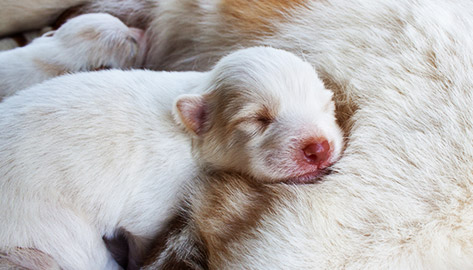
- Relatively helpless and rely completely on their mother
- Limited movement, cannot take the weight of their own bodies as yet
- Will vocalise when separated from its mother
- Feed by suckling from the mother
- Urinate and defecate by stimulation of the mother
- Kept clean by the mother
Transitional period (2-3 weeks):
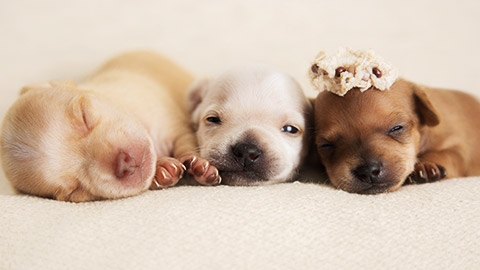
- Begin to socialise by practising growling and wagging their tail
- Begin to respond to light and movement
- Play fight with siblings
- Shows an interest in semi-solid foods
- Begin to relieve themselves away from the nesting area
Socialisation Period (3-12 weeks):
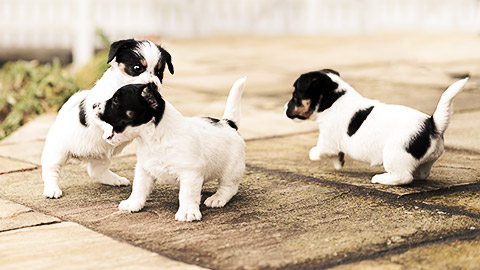
- Begin to show a startle response
- Begin to stand and walk
- Begin to bark
- Begin to wean from their mother
Juvenile Period (12 weeks to juvenile):

- Sense organs fully developed
- Growth rate slows
- Adult teeth appear
- Reaches sexual maturity
Adolescence:
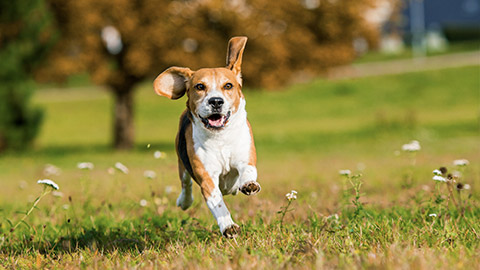
- Puppies mature very quickly, and the smaller the breed, the faster they reach maturity. In small breeds, adolescence can start as early as 5 months. In larger breeds, it can start as late as 9 or 10 months, and very large breeds might not go through adolescence until 12-18 months. When your dog reaches adolescence, you might see some or all of the following behaviours:
- aggression
- plenty of energy
- very short attention span
- poor socialisation
- disobedience
- wandering
- leg cocking (males); and
- obsessive mounting behaviour
Now, let's take a look at other species:
It is important to know the difference between clinical signs, abnormal behaviour and unwanted behaviour.
- Clinical signs are an involuntary physiological response to illness or injury.
- Abnormal behaviour is a behaviour that is generally out of character for that individual, is an atypical response to a stimuli or event or an increase or decrease in intensity of a typically 'normal' behaviour.
- Unwanted behaviour is a behaviour that is naturally expressed by an animal that does not fit into our human lifestyles.
Normal behaviours in cats and dogs
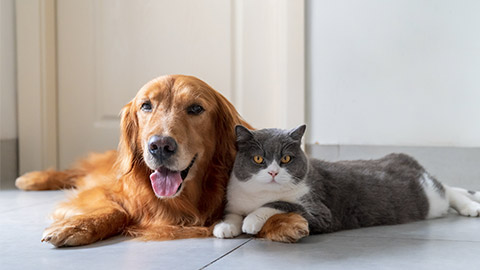
Dogs and cats as a species have normal behaviours, but we can also look at breed-specific behaviours.
Examples of normal behaviours in cats and dogs:
Cats |
Dogs |
|---|---|
|
Grooming
|
Social Interaction
|
|
Scratching
|
Barking and Vocalizing
|
Play and Hunting
|
Play and Chewing
|
|
Territoriality and Marking
|
Digging
|
|
Solitude and Sleep
|
Tail Wagging
|
|
Vocalizations
|
Sleeping and Resting
|
|
Pack Behavior and Hierarchy
|
Breed-specific examples:
- Working dogs – herding
- Pointers – pointing
- exotic cats - wool sucking
Abnormal behaviours in cats and dogs
Cats |
Dogs |
|---|---|
|
Excessive Grooming or Over-Grooming
|
Separation Anxiety
|
|
Inappropriate Elimination
|
Aggression
|
|
Aggression
|
Destructive Chewing or Digging
|
|
Lethargy or Lack of Activity
|
Excessive Barking or Whining
|
|
Excessive Vocalization
|
Lethargy or Lack of Interest
|
|
Pacing or Restlessness
|
Compulsive Behaviors
|
|
Loss of Appetite or Excessive Eating
|
Loss of Appetite or Overeating
|
|
Excessive Panting or Restlessness
|
Unwanted behaviours in cats and dogs
Vocalising (not excessive), digging, chewing, chasing, some displacement behaviours such as redirected aggression (where a cat or a dog sees another animal outside that they wants to attack but can’t get access to it they will then redirect their aggression to the next person or animal that comes near them)
Clinical signs
Self-mutilation due to pain, coprophagia due to malnutrition, stereotypic behaviours due to neurological disease, and inappropriate urination due to a UTI.
It is important to keep in mind that you cannot look at behaviour as an isolated event. You need to be aware of the history of the animal and also look at the environment. A behaviour is partially influenced by the animal's surroundings and its lived experience.
For example, excessive vocalisation could be due to stress because the animal has previously always been with the company and has now been left alone with no enrichment. A normally placid dog becomes extremely fear-aggressive when approached by someone wearing a helmet. This could be because of a past trauma, and the animal has been conditioned to fear this.
Sometimes, you are working with or assisting animals, and you must use strategies to encourage natural behaviour. It is important that these strategies are identified and implemented, signs of stress are recognised, and the possible stressors are determined.
Strategies to encourage natural behaviour, including activities and equipment

Strategies to encourage natural behaviour may include:
- Activities and equipment:
- To encourage foraging or hunting for food appropriate for species
- To provide exercise, physical fitness, and dexterity relevant to animal species
- To provide opportunities to live and socialise in an environment appropriate for particular species
- To rest, hide or shelter inappropriate housing
- To reinforce the role of owner or handler in an appropriate context for the nominated species
One of the strategies that might be used is known as temperament testing, which is quite often used to ascertain whether an animal is suitable for adoption and what type of person or home it would be suited for.
For example:
- "You have a dog that is in and is looking for adoption, so you test the dog’s temperament using your clinic’s testing guide (see example of guide below)
- As you are walking past the cat cages, the dog reacts aggressively towards the cat. You complete the testing, and everything else is good; you walk the dog back past the cat area repeatedly. He reacts aggressively toward the cats.”From the example above, you can see that the dog is aggressive with cats; therefore, you would note that this dog should not be homed with cats.
Factors to consider before developing enrichment programs

The strategies you use to encourage natural behaviours in animals need to be thought out and considered well. They need to include consideration of the following:
- The cognitive ability of the animal species
- Providing age-appropriate enrichments and individual animal needs
- Social groupings and hierarchy
- Novel food and potential dietary consequences, including toxicity and parasitic infection
- Safety of objects and infrastructure
- Introducing new enrichments – observing animal reactions
- Breed specifications e.g., social, herd, mentality and working
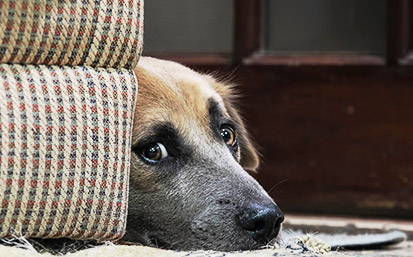
Signs of Stress
| Physical Signs | Behavioural Signs | Physiological Signs |
|---|---|---|
|
Panting (in Dogs)
|
Aggression
|
Increased Heart Rate
|
|
Dilated Pupils
|
Hiding or Avoidance
|
Excessive Shedding
|
|
Trembling or Shaking
|
Excessive Vocalization
|
Frequent Urination or Marking
|
|
Loss of Fur (Over-Grooming in Cats)
|
Destructive Behavior
|
|
|
Excessive Drooling
|
Pacing or Restlessness
|
|
|
Digestive Issues
|
Changes in Grooming Habits
|
The animal may show signs of stress whilst in the cage, but once outside, it is completely different and relaxed; this would indicate that they don’t like to be in confined spaces, etc…

It is extremely important that any abnormal behaviour that might indicate less than optimum physical and behavioural well-being MUST be reported to a supervisor (senior nurse), manager or other person in authority.
This will mean using the facilities' communication procedures systems, and technology that will be relevant to your organisation and work responsibilities
It is important that you learn how to:
It is important that you learn how to read the body language of animals, as this is crucial to the handling of the animals in a safe and responsible manner.
By tapping into your ability to empathise and learning to recognise the signs of stress, boredom, fear and anxiety, you can utilise your understanding of behaviour as a key component of restraint, treatment and diagnosis in any setting.
Keeping the animals as calm and happy as possible makes their experiences positive.
You should watch the animals for any abnormal behaviour which may indicate a less than optimum physical and/or behavioural well-being must be reported.
What is abnormal behaviour? This includes:
- Exaggerated forms of normal behaviour:
- Non-stop barking
- Constant digging
- Repetitive patterns or actions:
- Pacing in straight lines or figure eight patterns
- Restlessness
- Stationary, non-purposeful movements:
- Head tossing
- Swaying
- Self-mutilation
